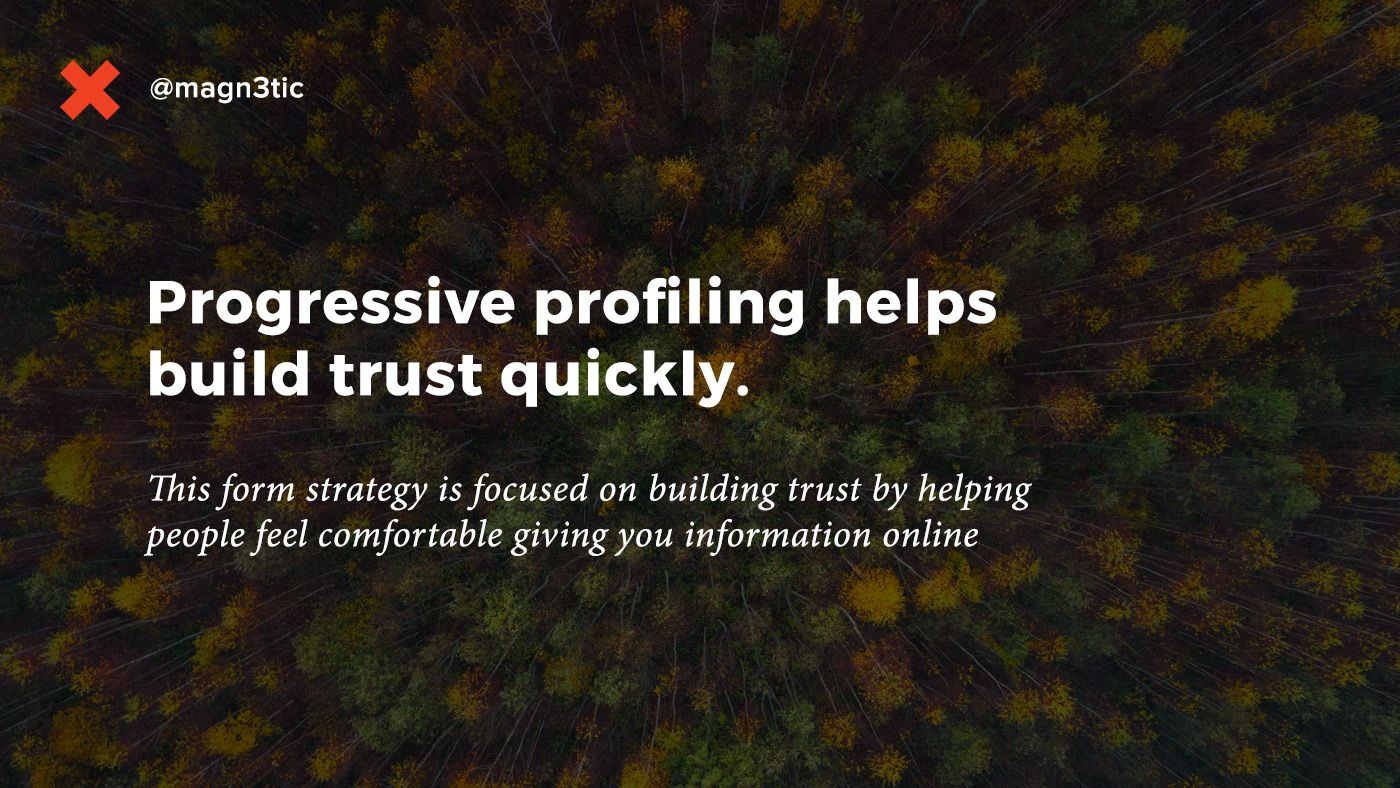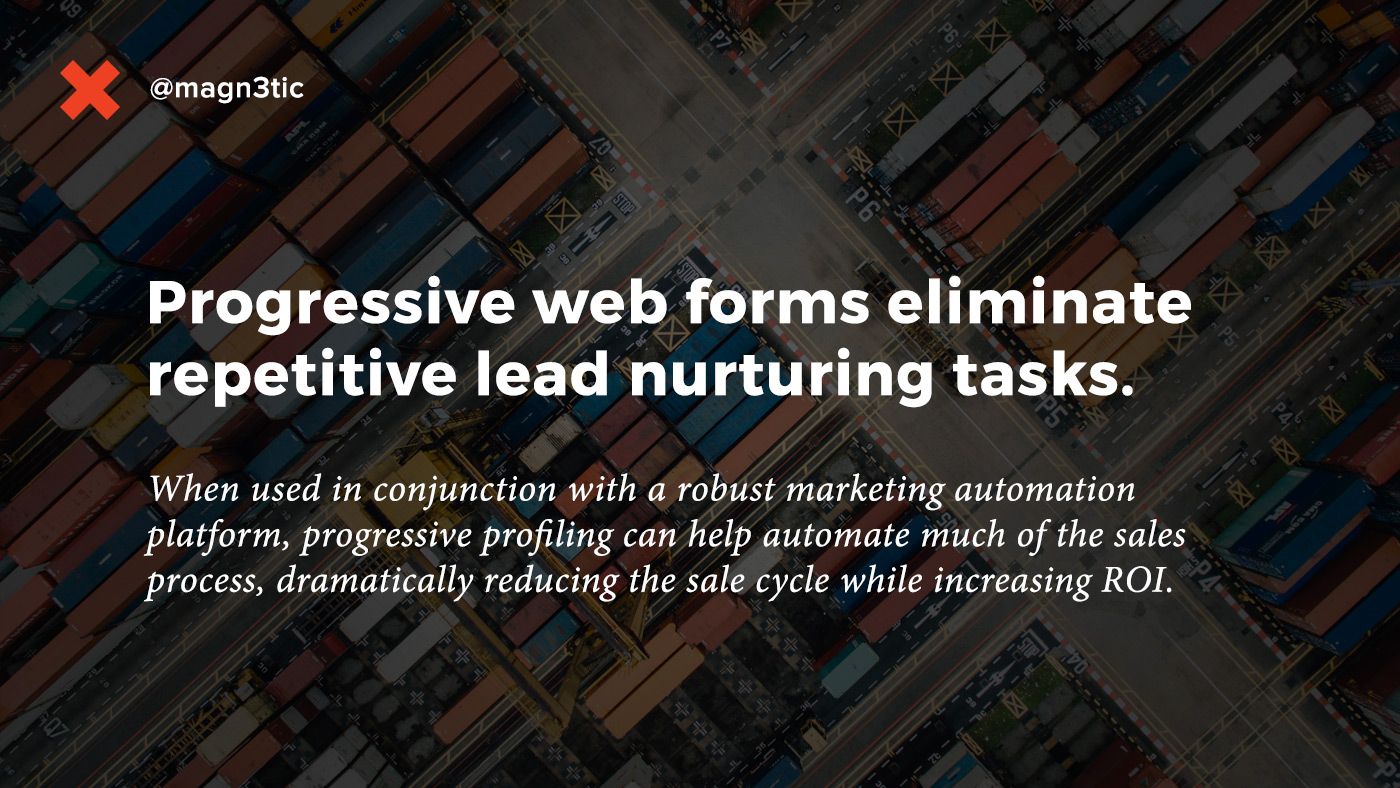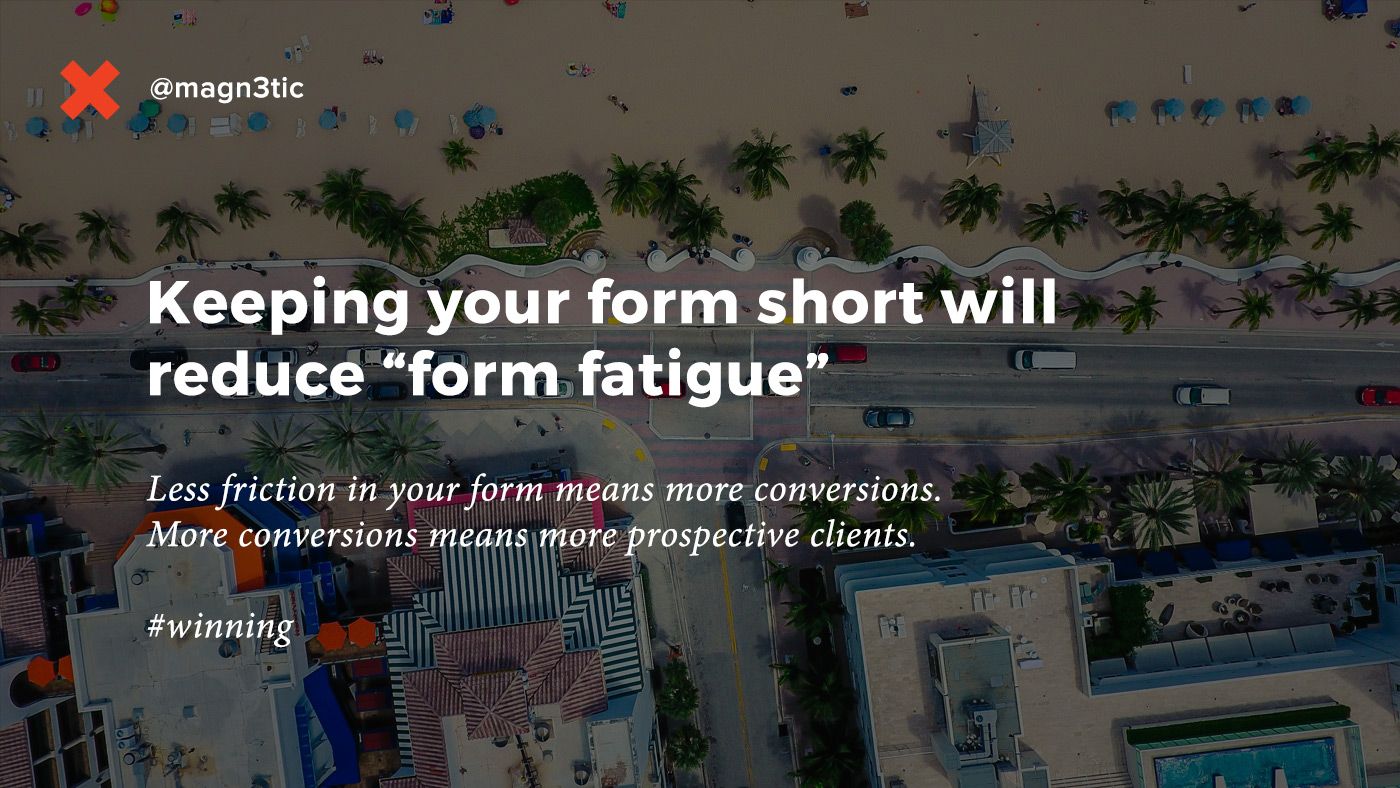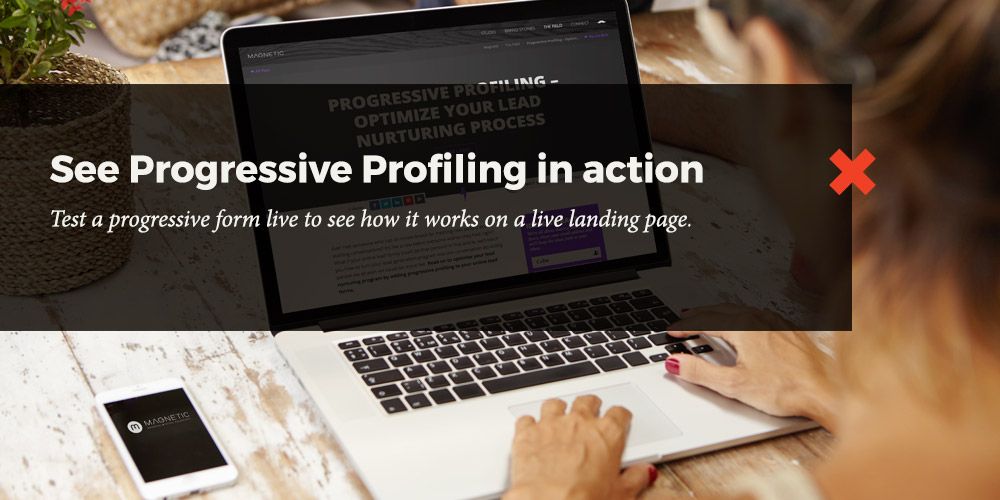Ever met someone who has an innate knack for meeting new people and starting conversations? It’s like a raw talent everyone wishes they had, right? What if your online lead forms could be that person? In this article, we’ll teach you how to turn your lead generation program into the conversation attracting person we all wish we could be more like. Read on to optimize your lead nurturing process by adding progressive profiling to your online lead forms.
Specifically, in this article you’ll learn:
- What progressive profiling means – Go there now >
- Progressive form best practices and how to optimize your marketing automation strategy – Go there now >
- How to prepare your sales and marketing teams for more, higher quality leads – Go there now >
- New lead generation and sales automation ideas – Go there now >
And the best part… this article gives you real-world lead nurturing examples you can start using today.

What you learn in this article can change the game for your sales and marketing teams. Here are a few key stats to get them on board with (and drooling over) your new lead gen strategy:
- 42% increase in form submissions – we’ve reported as much as 42% increase in form submissions by implementing progressive lead forms
- 61% increase in marketing qualified leads – up to 61% increase in MQLs generated by implementing progressive profiling into marketing automation strategies
- 27% increase in sales opportunities – organizations successfully implementing progressive forms to their sales and marketing process have seen up to 27% increase in sales accepted opportunities influenced by the form strategy outlined in this post
In short, the leads you’re about to start delivering are gonna keep the coffee flowing… #ABC ;)
What is Progressive Profiling?
Progressive profiling is the act of sequentially gathering more information about the people visiting your website using dynamic web forms in a manner that enhances user experience. Progressive lead forms allow you to collect the right information from the right people at the right time while dramatically enhancing the user experience.
Most commonly used in conjunction with a marketing automation platform and CRM like Hubspot or Marketo, progressive form fields enable dynamic, strategically posed questions to further qualify web visitors as sales prospects and eventually sales qualified leads.
Using dynamic forms and form fields on your website you’re able to progressively ask for new pieces of information about your lead using the same form each time they interact with it. Progressive forms allow you to learn more about your web visitors’ interests, needs, and demographic profiles each time they interact with you online.
Instead of bombarding your visitors with too many questions and form fields the first time you digitally meet them, progressive forms allow you to ask for more information when the time is right without asking your leads for the same piece of information multiple times.
This method of digital interaction enhances the user experience by making people feel more comfortable when submitting forms online. It resembles in-person relationship building and will increase your conversion rates.
There are also dedicated form shorteners that can auto-fill lead information with details already available from other resources. Tools like HubSpot’s form shortener automatically enrich form fields whenever it finds already-existing prospect-specific details.
For example, if a prospect types in their company email address, the form shortener will auto-complete details like company name, size, and job titles by looking up information within your CRM or across the web. These details are filled in the back-end, which minimizes the number of user-side form fields.
Here’s a quick video of me walking through the form example:
In short, progressive profiling is all about making people feel comfortable giving you information online
Making people feel comfortable with you online will help you collect the right information about them at the right time. This method of digital engagement enables you to present more relevant content to people online in the future.
Want to see a progressive profiling in action? Cruise over to our progressive form example! It’s a quick demo we set up to show you a working example of progressive form fields.
What are the Benefits of Progressive Profiling?
- Shorter lead forms
- Higher conversion rates
- Collecting more relevant information about your leads
- Building more authentic relationships with your leads and customers
When implemented correctly, progressive profiling in web forms eliminates much of the repetitive lead qualification process generally managed in a manual format by a sales representative. When used in conjunction with a robust marketing automation platform, progressive profiling can help automate much of the sales process, dramatically reducing the sale cycle while increasing ROI of sales and marketing activities.
Progressive Profiling explained in layman’s terms
Progressive profiling is simply the act of collecting more information about your leads as they continue to engage on your website.
Remember our friend who has the knack for meeting new people with style and grace?
Imagine meeting that same person for the first time in public… instead of simply asking you your name or something situationally relevant, they ask you immediately for your email, your phone number… your annual income, marital status, position at your company and how many people work there… and what if as they’re asking you all these intrusive questions, they’re writing it all down… creepy right?
Instead, in real life, just like our strikingly awesome friend would do, we progressively get to know people. We might have a conversation the first time we meet and explore topics of similar interest and exchange names.
The second time we see each other another conversation takes place where we continue to explore topically relevant interests. If the conversation goes well and enough interest or value is exchanged, we may trade phone numbers or email address’.
The third time we meet there is likely some trust built… this is where details begin to be shared and action is taken. At last, a relationship is built.
With progressive profiling, we’re trying to emulate this relationship and trust building in an online environment.
 How digital marketing teams benefit from progressive profiling:
How digital marketing teams benefit from progressive profiling:
If you’re responsible for digital marketing (even in part), reading this post will prepare you to:
- Learn more about people engaging with your website content
- Nurture leads in a more meaningful and streamlined process
- Integrate progressive profiling forms to your website
- Convert more leads using shorter forms
- Avoid repetitious form questions in your lead nurturing process
- Integrate progressive profiling to your digital marketing strategy
We’ll also introduce a few new lead generation ideas as a bonus towards the end of the post.
How sales teams benefit from a progressive lead form strategy:
- Save countless hours of manual lead qualification
- Engage with higher quality leads when they’re most actively engaged with your product or service online
- Gain a deep understanding of your lead’s decision making power and real-time operational needs
- Eliminate wasted time selling to unqualified sales prospects
- Open sales conversations with precise context to position within buyers journey
For the sales team, we’ll be adding a few sales automation tactics you can implement today as a bonus to making it to the end of the post… worth it, we promise ;)
Just a heads up for both sales and marketing… the tactics outlined in this post can make a dramatic impact on your business. One of the best things you can do is to be prepared to report on this impact. Take a snapshot of your current lead gen success rate to benchmark the impact.
It also wouldn’t hurt to get a little 1 or 2 liner ready explaining how the sales and marketing teams have finally joined forces and exactly who (you) has influenced this new approach ;)
Let’s dig in!
Progressive profiling best practices – Optimizing your marketing automation strategy
If you’re using a Marketing Automation Platform currently, implementing progressive lead forms isn’t too difficult. There are a few key points we’ll need to define to make this exercise impactful.
Before we can effectively implement a progressive lead form, we need to define what information we want to collect from our visitors. Typically we break this information down into three stages or touch points…
First touch form interaction – Top of Funnel
This is the information we collect on our first digital engagement with our visitors. This is commonly referred to as Top of Funnel lead data. We recommend keeping your first touch lead capture form fields as short as possible:
- First Name
- Last Name
- Email address
Keeping your form short will decrease the mental friction your web visitors feel when deciding whether or not to fill it out. The effect of long forms is called “Form fatigue” or “survey fatigue” – we’re always shooting for the opposite in our first touch forms.
Be sure to include some lead form call-to-action text to explain why someone should fill your form. People are more likely to interact with your form the first time when you do a good job illustrating why they should submit and what value they’ll receive by doing so.
Here are a couple lead form call-to-action examples you’re welcome to use:
EXAMPLE 1
“Are you interested in achieving more (product or service benefit)? We can help! Let’s get to know each other first:”
[ insert first touch interaction form ]
EXAMPLE 2
“Want to know how (product or service feature) could help your company realize more (product or service benefit)? Fill out the form below to get started…”
[ insert first touch interaction form ]
Second touch form interaction – Middle of Funnel
This is where progressive forms get fun… now we’re able to get a bit more specific with what information would be useful to know about our new lead.
To be clear, your first touch and second touch form interactions will not be presented at the same time. All questions queued after your first touch form questions will show the next time your lead sees the form on your website.
What you ask people here will vary based on your brand, service, product, and customer persona. We have some general recommendations below… however… this is a great opportunity to get a meeting organized between a select few sales and marketing stakeholders.
Here’re some second interaction lead form fields to consider for your progressive form:
- Industry
- Company Name
- Country
- Postal Code
We suggest our clients keep their forms limited to three or four fields at a time in order to increase conversion. There are, of course, data quality requirements often in place within corporations which can expand mandatory fields and data collection in forms.
When applicable, we recommend getting personal in order to build more trust with your prospects. Instead of just presenting the next 3 form fields, here are some ideas to build trust and make your new contact feel progressively more comfortable…
Let your lead know you recognize them
Replace any form specific call-to-action text with something personalized.
For instance, if ‘Industry’ and ‘Company’ were the most important pieces of information we are interested in collecting next, we could say something like:
Great to see you again, {First Name}! Did you know companies in all major industries are seeing [insert top level product or service benefit] from [insert top level product or service feature]? Can we show you some examples specific to your Industry?
1st Form Field: [ What Industry are you in? ]
2nd Form Field: [ What Company do you represent? ]
3rd Form Field: [ Insert Personal Question Here… Read on to learn how ]
The curly brackets { } around “First Name” above represent personalization tokens. Since we know the contacts first name already based on their first touch interaction form submission, we can use it on the website and in automated emails. You’ll see these curly brackets a few more times in this post, so take note ;)
Notice how we only included two progressive form fields? Here’s why…
We like to keep forms as short as possible and semi-conversational. We recommend this strategically to increase form conversion rates and again, to make people feel comfortable. Instead of just asking for another piece of contact information in your next form field, ask something more personal.
Collecting personal information about your contact will enable your sales team to open their first call with the contact in a much more conversational format. See where we’re going with this 😉

Keep your branding consistent during form personalization
Remember to approach this personal question with your brand in mind… it should feel appropriate to your offering and brand tone and voice.
Form select options tend to work well for personal questions in the second interaction form.
Here’s an example of a second touch question you might ask to get more personal with your leads:
“Are you more likely to get lost in a good book or movie?”
Form Selection 1: [ I’m a Book Worm ]
Form Selection 2: [ Netflix and Chill ]
While this question might not seem relevant (or professional) to your business. You can learn a metric-shit-ton from the answer. Let me explain…
Knowing whether someone prefers to read or watch is a great educational piece of information for both your sales and marketing teams. If someone prefers to read, your marketing team should be aiming to provide specific textual marketing information to them. But if the person prefers to watch, communicating the same message with a quick video will make sure the intended message is both delivered and consumed.
For your sales team, knowing whether someone is more interested in books or movies will educate them on the best outreach platform. If they’re an avid reader, lengthy emails or PDF attachments will likely work best. Video people will be much more receptive to virtual calls and video chats.
In addition, and as a follow-up response to this second form submission, you might include a “p.s. – did you read/see that new book/movie?” – adding this personal touch builds trust and will likely skyrocket your response rate. Now a relationship is beginning to form.
Third touch form interaction (and beyond) – Bottom of Funnel
Once we know a few key pieces of contact information, it’s time to build more persona based information into our contact record. Collecting persona data will help you segment your audience into specific interest segments and illustrate their buying power within their organization.
Some examples of third touch progressive form fields are:
Job Role/Title
Remember to make this personal… instead of just asking “What is your Job Title?”
You can pose this question more personally by asking:
Form Field: [ “What role do you currently play at { Company Name }?” ]
Goals / Challenges
Remember how we collected the contacts industry in form 2? Ask the sales team for some insight into the 3-5 most common goals and challenges in each industry your company serves.
With progressive forms, we can supply a list of specific industry goals and challenges and present them contextually to each contact and their specific industry.
Save room for another personal question to accompany this form. While it’s not mandatory, hopefully, the book or movie question sparked some creative ideas for how to continue the personalization.
If not, drop a comment below and we’ll be glad to help!
How to add progressive questions to your form
Now that we have our progressive form questions mapped out, let’s look at how to implement them to our progressive form. In this example, we’ll be using a marketing automation platform to generate our form.
- Start by getting your contact properties set up for your form
- Prepare your form with your first touch, top of funnel questions
- Queue your second touch, middle of funnel questions to replace your first touch questions
- Queue your third touch, lower funnel questions
- Test your form and publish
Pro Tip:
If you’re creating new contact properties for your form, be sure your team is aware of them and knows what to use them for.
 How to prepare your sales and marketing teams for higher quality leads
How to prepare your sales and marketing teams for higher quality leads
We’ve all heard it before… communication is key. Communicate your new lead nurturing process and lead profiling process to your sales and marketing teams early. You’ll need their input and feedback to make the efforts successful.
One of the most noteworthy mistakes marketing teams can make is not informing salespeople of what to expect. Be sure not to make the same mistake with your progressive profiling and marketing automation programs.
The more the sales team understands (and influences) your progressive form strategy, the more prepared they’ll be to handle all the new leads coming in and more importantly… they’ll be able to manage the leads maturely and with poise.
Creative ideas on how to keep your internal teams aligned with your new lead nurturing process:
First of all, Be Human
Go talk to people. That’s right… get up and start a conversation. Not everything has to be scheduled and formal. I don’t care how corporate your work environment is. It shouldn’t matter whether you’re on the sales, marketing, or janitorial team. Get excited and share your passion for what you’re doing with the people around you.
The best ideas often come from informal collaboration. Practice it and watch the magic unfold.
Get Collaborative with a shared Google Doc
Share a Google Doc with your team illustrating the lead generation process and how it specifically pertains to each campaign effort. Identify which pages on your website will be best to introduce your new progressive form and why.
This gives your team an opportunity to collaborate in real time about what’s working and what’s not. Use this collaborative approach to share ideas about how to continually improve the lead generation process.
A shared google doc can be a great place to track and report performance as well… which leads to our next suggestion…
Track and report on program success
Tracking friction points and success’ of your progressive forms is key to continual optimization. Start and share a reporting mechanism where key stakeholders to the program can watch the progress and report any potential feedback.
Be sure to track each form and form interaction stage individually. The best feedback is specific and actionable. Creating your reporting documents with this in mind will help encourage specificity in feedback.
Video Communication
Long reports and emails can discourage participation… that’s why we’re big proponents of video as an internal communication tool. Check out SoapBox or Zoom as a potential solution for recording a video about your progressive profiling program. You’ll be surprised at how the feedback and interactions change when you incorporate your beautiful face into the equation.
New lead generation and sales automation ideas
As promised, we’ll close this article out with some new lead generation ideas and sales automation thought starters.
These are meant to be provocative. You’ll need to contextualize them to fit your branding narrative. The point is to get you thinking about lead-gen and automation tactics in a new way.
Progressive Lead Generation Ideas
These ideas are meant for first touch interactions. Before gathering too much information about your leads, it’s a great time to express brand personality and let your lead do the same. This doesn’t mean to relinquish strategic positioning from your forms online. Instead, have fun while strategically getting to know your web visitors…
Get personal – Creative Online Lead Form Questions
Instead of leading with stuffy questions the first time you meet people on your website, try getting personal first. We’re not trying to get awkward here. Instead, find creative ways to approach your lead form questions.
Online personality quizzes are a good source of inspiration for online lead form questions. Just be sure they’re in line with your brand persona. Here are a few to get you thinking:
- Who’s your favorite superhero?
- Where do you research new [product or service type] tools?
- Cat person or dog lover?
- What is your biggest [product or service type] challenge?
- Are you a salts or sweets person?
While some of these questions can seem odd or irrelevant, remember what we were able to deduce from our “Book Worm” or “Netflix and Chill” question. If nothing else, you end up with information your sales team can use to start personally relevant conversations. These icebreaker intros can make a huge impact in prospect response rate.
Feel free to go back to the “Book Worm” or “Netflix and Chill” example above. Rereading might help you figure out a way to apply the concept to your own brand and sequential form questions.
Fun Drop-Down Selections
Another fun tactic to test in your progressive forms… consider using quirky drop-down selections as the form response in your top-of-funnel forms. This is a way to psychologically entice your visitors while making them feel included.
If you’re technically able, you might even add visible percentages to response options in relation to what people have answered in the past. Doing this correctly will allow you to illustrate your brand voice and culture while learning a bit more about your leads in a progressive manner.
Remember… at this stage, it’s not as much about closing a deal as it is about making people feel comfortable and trusting in your brand.
Get Personal with Video Marketing
Consider including video in your form call-to-action. Doing so will communicate personality, build trust with your leads, and increase form submissions. A few ways to implement video into your lead-gen strategy are:
- Say hello and let people know what your answers are to the personal questions you’re asking them in the lead form
- Give your visitors some insight into why you’re excited to get to know them. You can also sneak some product benefits into this portion of the video
- Let your leads know what to expect. The worst feeling after you submit a form online is loneliness. Let your leads know what to expect by explaining it in a video. You’ll be amazed at how far this goes in relationship building… especially when you follow through on your promises.
Join Sales Calls
There’s no better way to understand the context of the sales process than to be present during a real-time call or in-person meeting. Talk to your sales team about opportunities to shadow them during their prospecting calls or meetings.
If you’re on the sales team, talk to your marketing automation team about opportunities to have them join you. If physically joining the sales meeting is not an option, consider recording the sales calls and reviewing them together. During the call review, see if you can pinpoint pivotal questions and answers during the call which can influence your online lead form flow.
Look for patterns in the sales calls to identify repeatable question/answer scenarios which continually influence the prospects to take the next step in the sale cycle.
Sales Automation
Be sure to follow through on the progressive lead nurturing process. As you continually refine your lead form strategy, also refine your automated sales communications and email follow-ups.
For example… if you use progressive form fields to learn more personal information about your leads, be sure to follow up in your automated email responses with contextually appropriate verbiage. We’ll often segment follow up emails into variations based on form field responses in order to create a unique experience for audience segments.
A/B Testing Your Progressive Forms and Refine
A/B testing your forms is a great way to test new ideas. When you have new ideas to introduce to your lead gen forms, test them before going all in.
A/B testing will allow you to put your ideas into action without over-committing to them. You’ll be able to see which form fields increase conversion rates and, most of all, sleep better at night knowing your forms are working for you.
Progressive Lead Forms and GDPR (General Data Protection Regulation)
As with all online data collection, your progressive forms should include GDPR compliance best practices. Your progressive forms should include consent checkboxes with accompanying consent language, links to your GDPR compliant privacy policy, and a description of what your organization will be using the data collected in the form for.
Build trust and enhance user experience with GDPR options
Making your progressive forms GDPR compliant has a tendency to complicate the visual appearance of the form. While this can lead to form fatigue for your users, it also illustrates your commitment to data privacy. When designed well, adding GDPR compliance to your form can help to visually build trust with your users.
GDPR and marketing automation
If your organization is using a marketing automation platform, they likely have resources available for enabling GDPR compliance on your progressive profiling forms.
For help learning about GDPR compliance in marketing automation, feel free to use the links below to view options within some well-known marketing automation platforms:
- Learn more about GDPR compliance in Hubspot
- Explore GDPR compliance in Marketo
- More info on GDPR compliance in Eloqua
- GDPR compliance in Pardot
Please note: neither the author of this article nor Magnetic Creative or its employees are qualified to provide legal counsel on GDPR compliance. You need to talk to your lawyer about the issue if you’re unsure if your company is in compliance.
For more information on the General Data Protection Regulation, please visit the 2018 reform of EU data protection rules on the European Commission website.
Time to roll up the sleeves and optimize your lead nurturing process
We hope this article has been useful and actionable for your lead-gen and marketing automation program. Don’t stop here though. These ideas and tactics should act as a springboard for maturing your lead generation strategies.
Just like any digital marketing strategy, your progressive profiling strategy should be constantly evolving. After you’ve launched your first few progressive lead generation ideas, go back and assess what’s working and what’s not. When you see an opportunity to optimize your conversion rates, do it. Be collaborative and include your sales and marketing teams in the process.
We’re excited to hear what ideas you put to work. Please share any questions, comments, concerns, and especially your successes with us in the comments.
Stoked to see you succeed.




Join the Discussion